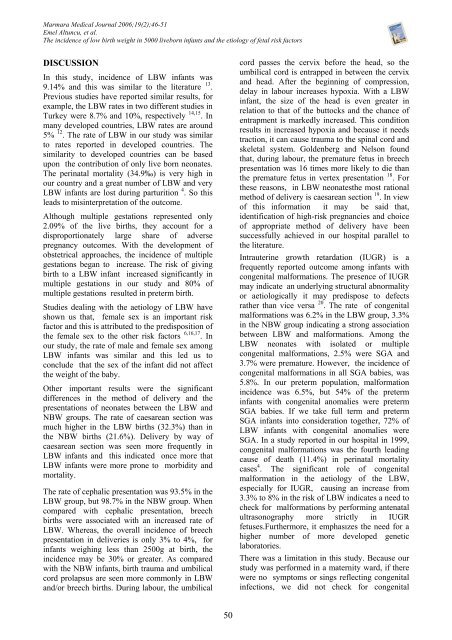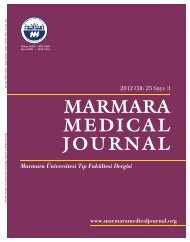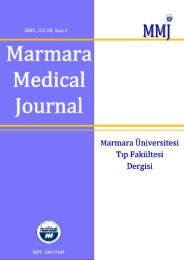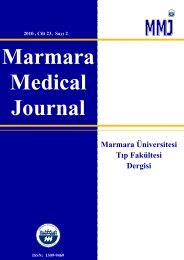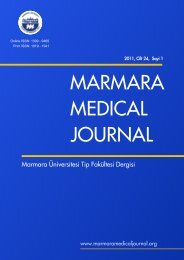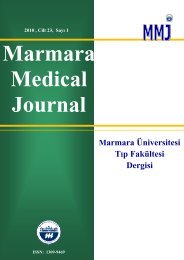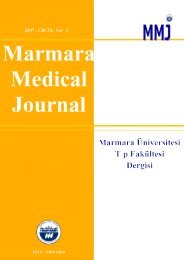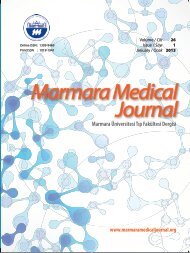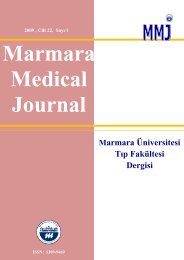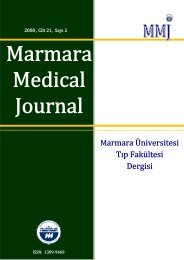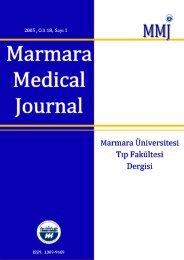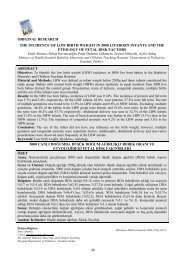Tam Metin PDF (3983 KB) - Marmara Medical Journal
Tam Metin PDF (3983 KB) - Marmara Medical Journal
Tam Metin PDF (3983 KB) - Marmara Medical Journal
Create successful ePaper yourself
Turn your PDF publications into a flip-book with our unique Google optimized e-Paper software.
<strong>Marmara</strong> <strong>Medical</strong> <strong>Journal</strong> 2006;19(2);46-51<br />
Emel Altuncu, et al.<br />
The incidence of low birth weight in 5000 liveborn infants and the etiology of fetal risk factors<br />
DISCUSSION<br />
In this study, incidence of LBW infants was<br />
9.14% and this was similar to the literature 13 .<br />
Previous studies have reported similar results, for<br />
example, the LBW rates in two different studies in<br />
Turkey were 8.7% and 10%, respectively 14,15 . In<br />
many developed countries, LBW rates are around<br />
5% 12 . The rate of LBW in our study was similar<br />
to rates reported in developed countries. The<br />
similarity to developed countries can be based<br />
upon the contribution of only live born neonates.<br />
The perinatal mortality (34.9‰) is very high in<br />
our country and a great number of LBW and very<br />
LBW infants are lost during parturition 4 . So this<br />
leads to misinterpretation of the outcome.<br />
Although multiple gestations represented only<br />
2.09% of the live births, they account for a<br />
disproportionately large share of adverse<br />
pregnancy outcomes. With the development of<br />
obstetrical approaches, the incidence of multiple<br />
gestations began to increase. The risk of giving<br />
birth to a LBW infant increased significantly in<br />
multiple gestations in our study and 80% of<br />
multiple gestations resulted in preterm birth.<br />
Studies dealing with the aetiology of LBW have<br />
shown us that, female sex is an important risk<br />
factor and this is attributed to the predisposition of<br />
the female sex to the other risk factors 6,16,17 . In<br />
our study, the rate of male and female sex among<br />
LBW infants was similar and this led us to<br />
conclude that the sex of the infant did not affect<br />
the weight of the baby.<br />
Other important results were the significant<br />
differences in the method of delivery and the<br />
presentations of neonates between the LBW and<br />
NBW groups. The rate of caesarean section was<br />
much higher in the LBW births (32.3%) than in<br />
the NBW births (21.6%). Delivery by way of<br />
caesarean section was seen more frequently in<br />
LBW infants and this indicated once more that<br />
LBW infants were more prone to morbidity and<br />
mortality.<br />
The rate of cephalic presentation was 93.5% in the<br />
LBW group, but 98.7% in the NBW group. When<br />
compared with cephalic presentation, breech<br />
births were associated with an increased rate of<br />
LBW. Whereas, the overall incidence of breech<br />
presentation in deliveries is only 3% to 4%, for<br />
infants weighing less than 2500g at birth, the<br />
incidence may be 30% or greater. As compared<br />
with the NBW infants, birth trauma and umbilical<br />
cord prolapsus are seen more commonly in LBW<br />
and/or breech births. During labour, the umbilical<br />
cord passes the cervix before the head, so the<br />
umbilical cord is entrapped in between the cervix<br />
and head. After the beginning of compression,<br />
delay in labour increases hypoxia. With a LBW<br />
infant, the size of the head is even greater in<br />
relation to that of the buttocks and the chance of<br />
entrapment is markedly increased. This condition<br />
results in increased hypoxia and because it needs<br />
traction, it can cause trauma to the spinal cord and<br />
skeletal system. Goldenberg and Nelson found<br />
that, during labour, the premature fetus in breech<br />
presentation was 16 times more likely to die than<br />
the premature fetus in vertex presentation 18 . For<br />
these reasons, in LBW neonatesthe most rational<br />
method of delivery is caesarean section 19 . In view<br />
of this information it may be said that,<br />
identification of high-risk pregnancies and choice<br />
of appropriate method of delivery have been<br />
successfully achieved in our hospital parallel to<br />
the literature.<br />
Intrauterine growth retardation (IUGR) is a<br />
frequently reported outcome among infants with<br />
congenital malformations. The presence of IUGR<br />
may indicate an underlying structural abnormality<br />
or aetiologically it may predispose to defects<br />
rather than vice versa 20 . The rate of congenital<br />
malformations was 6.2% in the LBW group, 3.3%<br />
in the NBW group indicating a strong association<br />
between LBW and malformations. Among the<br />
LBW neonates with isolated or multiple<br />
congenital malformations, 2.5% were SGA and<br />
3.7% were premature. However, the incidence of<br />
congenital malformations in all SGA babies, was<br />
5.8%. In our preterm population, malformation<br />
incidence was 6.5%, but 54% of the preterm<br />
infants with congenital anomalies were preterm<br />
SGA babies. If we take full term and preterm<br />
SGA infants into consideration together, 72% of<br />
LBW infants with congenital anomalies were<br />
SGA. In a study reported in our hospital in 1999,<br />
congenital malformations was the fourth leading<br />
cause of death (11.4%) in perinatal mortality<br />
cases 4 . The significant role of congenital<br />
malformation in the aetiology of the LBW,<br />
especially for IUGR, causing an increase from<br />
3.3% to 8% in the risk of LBW indicates a need to<br />
check for malformations by performing antenatal<br />
ultrasonography more strictly in IUGR<br />
fetuses.Furthermore, it emphasızes the need for a<br />
higher number of more developed genetic<br />
laboratories.<br />
There was a limitation in this study. Because our<br />
study was performed in a maternity ward, if there<br />
were no symptoms or sings reflecting congenital<br />
infections, we did not check for congenital<br />
50


